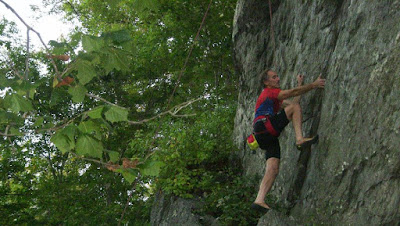 |
| Simon Carr, 64, leading Sinecure, 5.9, South Wales Photo: John Eales |
Rock climbing is not for everybody.
But don’t let your age discourage you from giving it a go, veteran climbers say.
“Being older doesn’t matter,” says Simon Carr, 64, a long-time climber from the Washington, D.C., area. “One great aspect of climbing is that you can have fun no matter what grade you climb.”
To minimize your risk exposure, start by learning to top rope, the safest form of climbing, the veterans say.
“Taking classes at an indoor climbing gym is a good way to learn the basics,” says Peter Parker, 62, Wintergreen, Va.
“Climbing gyms . . . have introductory classes and meet-up type events for new climbers,” adds Lew Glasener, 72, a climber from the northern Virginia area.
Some senior climbers have been at it over the long haul. Carr, for example, first started climbing 46 years ago, during his university days in New Zealand.
Glasener first tied into a climbing rope 36 years ago, when he was 36. “I’ve been climbing half my life,” Glasener says.
Plenty of others don’t start climbing until they are older.
Carol Clayton, 66, another D.C.-area climber, didn't start until she was 60. Parker was already 56 when he first learned to buckle a climbing harness properly.
Carol Clayton, 66, another D.C.-area climber, didn't start until she was 60. Parker was already 56 when he first learned to buckle a climbing harness properly.
Many outdoor climbers say they were drawn to the sport by their attraction to the physical challenge, and their love for the outdoors.
Carr says that part of climbing’s appeal for him has been the opportunity it presents for camaraderie with his climbing partners.
“I tend to climb with friends, and that’s an important part of the activity,” Carr says. “My choice of partners is that you won’t kill me and you are fun to be with, nothing to do with how hard you climb.”
If you do try climbing, you’ll figure out quickly whether it’s for you or not.
But don’t make the mistake of thinking you are too old to try it, just because you may not be able to climb as hard as some of the world’s younger rock stars.
"Be competitive with your own fitness level, and don't compare with others, especially not younger people," Clayton says.
"Be competitive with your own fitness level, and don't compare with others, especially not younger people," Clayton says.
“There’s a lifetime of climbing available at lower grades,” says Carr.
“It’s so important as we age to have regular exercise,” adds Glasener. “I think the younger climbers think it's cool that I'm still at it.”
 |
| Clayton, topping out at Seneca Rocks, W.V. Photo: Nancy Tran |
 |
| Glasener, 72. getting his jams in, Joshua Tree |
 |
| Glasener heading for the crag |
 |
| Parker using his spider moves on schist |
 |
| Carr at El Potrero Chico, Mexico |







